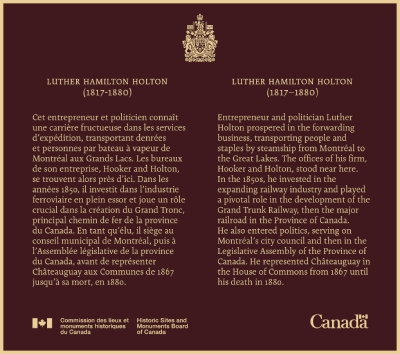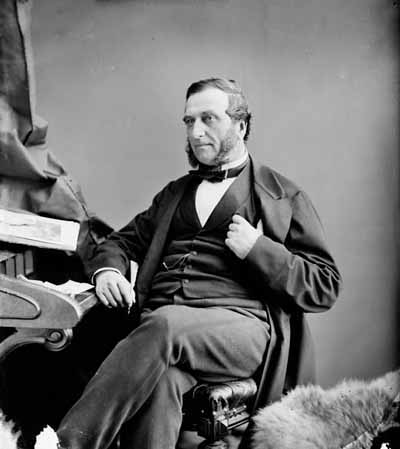Luther Hamilton Holton National Historic Person (1817-1880)
Luther Hamilton Holton (1817-1880) was designated a national historic person in 1938.
Historical importance: Successful businessman involved in a variety of timely interests, he played a pivotal role in the development of the Grand Trunk Railway. A prominent politician, he was Minister of Finance (1863-1864).
Commemorative plaque: MontrealFootnote 1
Entrepreneur and politician Luther Holton prospered in the forwarding business, transporting people and staples by steamship from Montréal to the Great Lakes. The offices of his firm, Hooker and Holton, stood near here. In the 1850s, he invested in the expanding railway industry and played a pivotal role in the development of the Grand Trunk Railway, then the major railroad in the Province of Canada. He also entered politics, serving on Montréal’s city council and then in the Legislative Assembly of the Province of Canada. He represented Châteauguay in the House of Commons from 1867 until his death in 1880.
Luther Hamilton Holton (1817-1880)
Luther Hamilton Holton was an entrepreneur and politician in mid-19th century Montréal. During the age of great railway expansion, he prospered in the forwarding business, transporting people and staples by steamship from Montréal into the Great Lakes. His business interests later moved to rail construction and in the 1850s, he played a pivotal role in the development of the Grand Trunk Railway, then the major railroad in the Province of Canada. He was also a politician in the years before and after Canada’s Confederation. Influential in Montréal’s civic life, he also served as member of the Legislative Assembly for the Province of Canada and briefly as its Finance Minister (1863-64). Following Confederation, he held a seat in both the provincial and federal governments and, from 1867 until his death, he was a member for Chateauguay in the House of Commons.
er Hamilton Holton was born in eastern Ontario, in the present-day community of Soperton, and educated in Montréal where, at the age of twelve, he began his working life as a clerk. In 1836, he joined the forwarding firm of Henderson and Hooker. Holton was a senior partner by 1845, and the firm adopted the name Hooker and Holton. During the 1850s, Holton became increasingly involved in railway development, particularly in the Grand Trunk Railway (GTR), which was incorporated in 1852 and became a large and powerful corporation.
Holton retired from the GTR in 1857 to focus on politics. He began his political career as a member of Montréal’s city council in 1850-51. In 1854, he was elected to the Legislative Assembly of the Province of Canada, representing Montréal. Defeated in 1858, Holton remained outside parliament until 1862 when he was elected to the Legislative Council. In 1863, he resigned that post to become the short-lived minister of finance in the government of John Sandfield Macdonald and Antoine-Aimé Dorion. When he ran for a seat in the Legislative Assembly in 1863, he was defeated in Montréal Centre. In 1867, he became the member of parliament for Châteauguay in the first federal election, a post he held until his death in 1880.
The National Program of Historical Commemoration relies on the participation of Canadians in the identification of places, events and persons of national historic significance. Any member of the public can nominate a topic for consideration by the Historic Sites and Monuments Board of Canada.
- Date modified :

